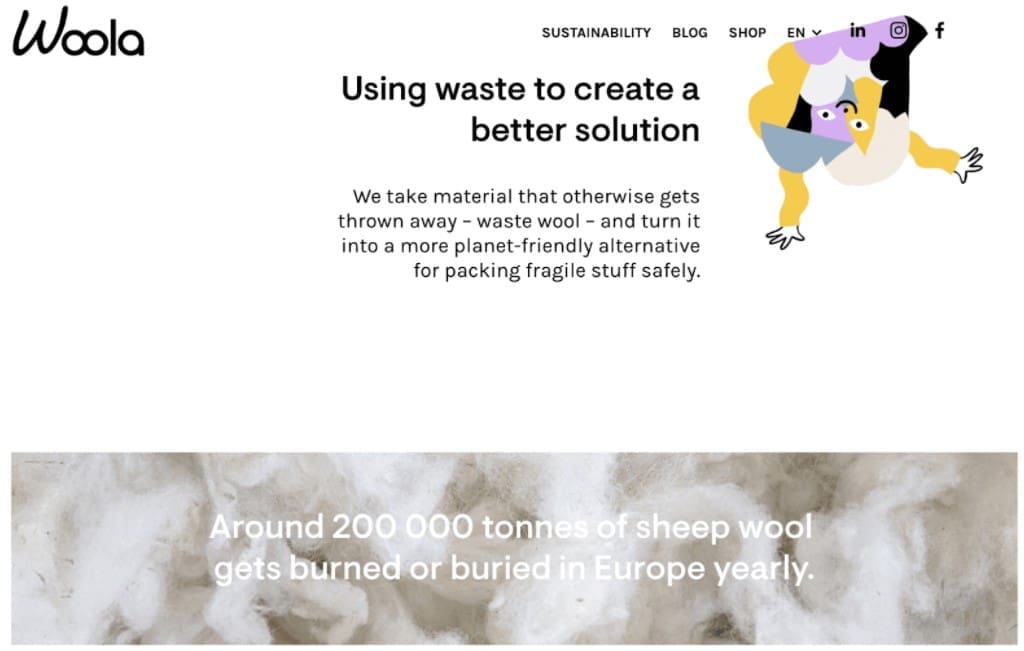A startup called Woola is betting that compostable wool could replace bubble wrap.

A sheep and her lambs via Pixabay
Recent estimates claim that over 10 million tons of plastic are dumped into the Earth’s oceans every year, thanks to about 380 million tons of plastic used annually.
If plastic use continues unabated, there will be more plastic than fish in our oceans by the year 2050. So, how can this be rectified?
The Problem With Plastic Bubble Wrap
For companies that package and ship products, bubble wrap has long been the primary method of keeping orders from breaking in transit. By one estimate, Amazon alone is responsible for 22 million pounds of plastic packaging that end up yearly in rivers, lakes, and the ocean.
One way to prevent an overflow of plastic from dumping into the oceans is by developing and using plastic alternatives.
For textile businesses, the bubble wrap problem represents an opportunity: convince shippers to replace bubble wrap with waste wool.
Waste Wool Could Be the Solution
Waste wool is the result of castoff wool from the production of yarn, woolen fabrics, or other items made primarily from wool.
Roughly 200,000 tons of waste wool are produced yearly, just in Europe, and some companies have decided that waste wool can still serve a purpose.
Since wool is naturally flexible, water-resistant and, best of all, biodegradable, it could be the perfect solution for protecting shipped items.

Waste Wool by Cgoodwin, CC BY 3.0, via Wikimedia Commons
Why Wool Packaging Works
Because wool fiber is biodegradable, it creates no harm to the environment when it is placed on or in the ground or water. The keratin protein contained in wool gives it natural elastic properties.
Most fish can consume this protein, meaning they can eat wool, while the salt in the land and water areas where there are no fish will break down the wool quickly.
Because waste wool is often imperfect or does not meet a wool manufacturer’s standards for regular wool products, it’s a perfect fit for irregular jobs like product packaging.
Waste wool can be made into bubble-textured sheets, similar to plastic bubble wrap, and it can be folded or wrapped around any product just as bubble wrap would be used. Since wool has natural insulating properties, when it is processed into a thick sheet, it provides a bouncy cushion that both protects fragile products and fills the empty space of packages and boxes.
How Companies Can Obtain Wool Packaging
Since wool packaging is still considered a new invention, there are not many industries creating this type of packaging, and there are very few using it.
Woola is a new startup aiming to change the world with more sustainable packaging so that plastic doesn’t fill up the oceans. The Estonian-based company’s co-founder, Anna-liisa Palatu, claims that “wool itself is a miracle material,” and that wool-based packaging is resistant to high temperature and humidity. It’s compostable within just 6 months, making it even higher in quality than plastic-based packaging.
Currently, Woola is only shipping their wool products to customers in Europe, but they do accept inquiries on their website for bulk and special orders. Other companies may be available in other countries outside of Europe, too, and businesses looking to obtain wool packaging can search for eco-friendly packaging products in their own areas.

Via Woola’s Website
How Wool Producers Can Use Waste Wool
Wool producers that end up with large quantities of waste wool can find creative ways to give it a purpose, either in packaging or otherwise.
For wool producers that ship their products regularly, waste wool can be used — processed or even unprocessed — as a replacement for plastic bubble wrap in packages or boxes. They can also consider adding a note to their recipients that the wool is being used as packaging instead of plastic and can be composted after the shipment is received.
If packaging is not needed, a company can instead repurpose waste wool by donating it to a wool packing company, or perhaps an animal shelter that can use the excess wool for animal bedding. Other ideas include composting the wool in a garden area or using the wool as house insulation.
Summary
Bubble wrap is one form of plastic that adds waste to the world’s oceans daily. However, plastic alternatives are being invented constantly, too, with wool-based packaging being one of them.
By using sustainable, compostable wool packaging, a business can not only help keep plastic out of the Earth’s waters but also give new life to wool that would otherwise just be wasted.
